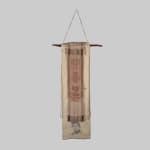Margaret Roach Wheeler
Grandmother's Story
Cross-stitched handwoven sampler on screen printed linen, needle and thread
51 x 15 in
129.5 x 38.1 cm
129.5 x 38.1 cm
Copyright The Artist
Further images
'Grandmother’s Story' speaks to the fiber work inherited through generations of women in her family, as well as to the cultural and personal resilience of her relatives. A divergence from...
"Grandmother’s Story" speaks to the fiber work inherited through generations of women in her family, as well as to the cultural and personal resilience of her relatives. A divergence from the fashion garments that Wheeler has become known for, this wall hanging centers on a piece of linen fabric stitched on by the artist’s grandmother, Juel Boyd Massey. The needle Massey used, still pinned to the fabric she had not finished stitching, sits as an heirloom symbol of the love of the craft that runs through generations. Wheeler in fact picked up from where her grandmother left off to complete the stitching at the bottom of the fabric. It is on this cloth that Wheeler then attached her own handwoven fabric—hand-dyed with mushrooms, elm bark, and oak gall she foraged—that she then embroidered like a sampler.
The English alphabet cross-stitched at the top reads in stark contrast to the defiant declaration below it: “I WILL NOT SPEAK ENGLISH! CHAHTA SIA! (I am Choctaw!)” Underneath is a list of Wheeler’s paternal ancestors, beginning with Jincy Beams, who “came to [Indian Territory] in 1833,” and ending with Johanna Choate, the artist’s paternal grandmother, who was “whipped for speaking Choctaw.” Choate’s portrait is printed at the bottom of Massey’s cloth. The threads of ancestral continuum are woven through every object Wheeler creates.
—Kaylan Bebout Roach
The English alphabet cross-stitched at the top reads in stark contrast to the defiant declaration below it: “I WILL NOT SPEAK ENGLISH! CHAHTA SIA! (I am Choctaw!)” Underneath is a list of Wheeler’s paternal ancestors, beginning with Jincy Beams, who “came to [Indian Territory] in 1833,” and ending with Johanna Choate, the artist’s paternal grandmother, who was “whipped for speaking Choctaw.” Choate’s portrait is printed at the bottom of Massey’s cloth. The threads of ancestral continuum are woven through every object Wheeler creates.
—Kaylan Bebout Roach











